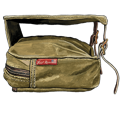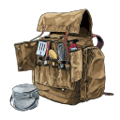Prep Your Canoe for Paddling Season in 10 Steps
De-winterizing a canoe
You’ve heard about winterizing your house, or your boat, spring cleaning, pulling your fiberglass-hulled bass-hunter out of storage, swapping out snow tires for summer wheels, storing your packs properly and keeping your goods in good order...
But there isn’t too much talk about taking your canoe from hibernation to summer paddling season.
Sure, there’s no pistons, no oil, no gas, no plugs, no electronics, but it’s a tool just the same, and there are some important points to take a look at to help get your canoe ready for summer so you don’t delay your all-important secluded summer getaway to pristine canoe country (or wherever you hit the water!).

Tips for Prepping a Canoe for Paddling Season
If you put your boat into storage for the season properly, you likely won’t have an issue with any of these, but it’s still good to give your boat a good inspection; it’s a matter of pride, and it is, after all, the only thing standing between you and the water!

1. Check for rot or mold
If you store your boat outside, especially on or near the ground, there’s potential for rot and mold, typically in wood or other natural materials. Check the thwarts, yoke, gunnels and any other points that were close to the ground or any wetness. If the wood looks like it needs some attention, consider refinishing it, repairing it, or replacing it. When in doubt, check with your local shop.
2. Check for cracks, deep scratches and holes
Regardless of what material your canoe is made from, stuff happens. Keep your boat ship-shape and make sure it’s watertight. Give the whole hull a once-over, especially if there was any incident that might have caused problems, which brings us to:
3. Think through the history
Did your boat wrap around or go over any big rocks? Did the thwart crack? Did you drop it in the middle of a portage? Think through what your boat went through the past couple seasons and take a close look at affected areas, they might need some repairs, and if they don’t you’ll feel confident knowing you’re good to go!
4. Check your registration
In a lot of places, Minnesota included, canoes are considered a watercraft that requires registration. Check your local laws and make sure that your boat is legal. It’s easy, not too expensive and a lot better than a ticket.
5. Check for stowaways
Who knows what’s crawled into the cracks and crevices of your canoe during the long hard winter months. Keep those creepy-crawly feelings at bay by checking for and removing those four, six, and eight-legged stowaways before they meet you at eye level with the canoe on your shoulders or wriggle down the back of your hand on your way to the car. 'Nuff said.
6. Inspect seats
This is where the rubber meets the road for most canoeists, and you don’t want to have to do repairs in the field. Take a look at the seats and make sure that they’re secure, that the frame is in good working order. If you’ve got cane or webbing seats, ensure the material isn’t dry-rotted or cracking. If you run into troubles, talk to your local canoe shop, consider re-varnishing, re-finishing or repairing. If it’s all in good order, take a look at our Canoe Seat Pad.


7. Get it shiny
Your boat’s been dormant for a few months, odds are it’s gotten some dirt and dust and duff. Make it shiny and keep your khakis their original shade of tan by giving your boat the ol’ spit-shine by cleaning it. It’ll thank you for it, and you and your packs will look better in a purty boat.
8. Make those upgrades
Remember that dream of kitting your boat out for whitewater, or that day you lost your hat because you didn’t have a bag to put it in, or a strap to tie it down? Think about those little upgrades you wished your boat had and make them happen now. Knees sore from taking the pommeling of big waves? Look at installing knee pads. Bow and stern looking a little rough? Think about skid plates. Portage Pads uncomfortable? Get some new ones! Butt sore from all-day sitting? Consider a Canoe Seat Pad!
9. Are your portage pads installed?
Don’t get to your Boundary Waters entry point and realize that you’re about to embark on a more traditional trip than you planned on… (portage pads have only recently become a mainstay of canoe travel). For whatever reason they came off of your boat, be it repairs, safe storage or upgrade, ensure that you have the pads with you. Your trapeziuses will thank you.
10. Check your gear and transport materials
What’s a canoe without a lake and without a paddle? Don’t forget to make sure your paddles are good and ready and that you can haul your boat to where you’re going to paddle it. Most of us don’t have the luxury of water on our own property, which means we’re moving the canoe from where it’s been stored or lives and bringing it to the water. There’s nothing worse than throwing your Camp Cook’s Kitchen and Thwart Bags into the trunk, getting ready to hoist the canoe to the roof, only to find you’re missing a strap or a pad. Get your gear in order, keep it organized (a zip-top tote like a Brighton Beach keeps is all in order) and put it where you can find it.

Most importantly...
...make a point to take your canoe out, dip your paddle and experience the water. Put it on your calendar, schedule your BWCA trip, grab your PFD and go canoeing. We all need a good paddling, after all!




